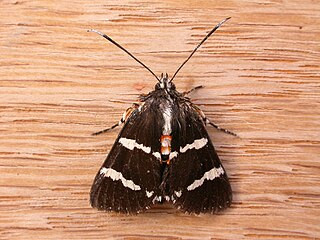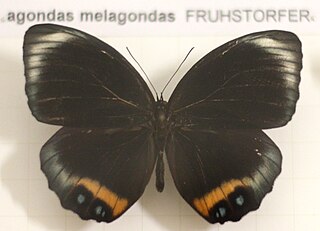
The Noctuidae, commonly known as owlet moths, cutworms or armyworms, are a family of moths. Taxonomically, they are considered the most controversial family in the superfamily Noctuoidea because many of the clades are constantly changing, along with the other families of the Noctuoidea. It was considered the largest family in Lepidoptera for a long time, but after regrouping Lymantriinae, Catocalinae and Calpinae within the family Erebidae, the latter holds this title now. Currently, Noctuidae is the second largest family in Noctuoidea, with about 1,089 genera and 11,772 species. This classification is still contingent, as more changes continue to appear between Noctuidae and Erebidae.

Jean Baptiste Alphonse Déchauffour de Boisduval was a French lepidopterist, botanist, and physician.

Noctuoidea is the superfamily of noctuid or "owlet" moths, and has more than 70,000 described species, the largest number of any Lepidopteran superfamily. Its classification has not yet reached a satisfactory or stable state. Since the end of the 20th century, increasing availability of molecular phylogenetic data for this hugely successful radiation has led to several competing proposals for a taxonomic arrangement that correctly represents the relationships between the major lineages.

Asterocampa, commonly called hackberry butterflies or American emperors, is a genus of butterflies in the family Nymphalidae found mainly in North and Central America and the Caribbean.

Zygaena is a genus of moths in the family Zygaenidae. These brightly coloured, day-flying moths are native to the West Palearctic.

Pithecops is a genus of butterflies in the family Lycaenidae erected by Thomas Horsfield in 1828.

Cocytia is a genus of moths in the family Erebidae. It is monotypic, being represented by the single species, Cocytia durvillii, an uncommon day-flying moth found in lowland areas of the Moluccas, Aru, and New Guinea. The species has clear wings bordered with black, with an orange patch at the base of each forewing and long antennae, thicker at the outer end. Both the genus and species were first described by Jean Baptiste Boisduval in 1828.

Hecatesia is a genus of moths of the family Noctuidae. The genus was erected by Jean Baptiste Boisduval in 1829.

Amata huebneri, commonly known as Hübner's Wasp Moth, is a species of moth in the family Erebidae. The species was first described by Jean Baptiste Boisduval in 1829. It is found from the Indo Australian tropics to northern Australia.

Sphinx is a genus of moths in the family Sphingidae. The genus was erected by Carl Linnaeus in his 1758 10th edition of Systema Naturae.

Hyles is a genus of moths in the family Sphingidae.
Lenyrhova is a genus of moths in the family Sesiidae which is known from eastern Madagascar.
Madasphecia griveaudi is a moth of the family Sesiidae. It is found in south-western Madagascar. It is only known from its male holotype that was caught at the Mahafaly Plateau.
Madasphecia puera is a moth of the family Sesiidae. It is known from eastern Madagascar. This species is attracted to ultraviolet light.

Oeneis melissa, the Melissa Arctic, is a species of butterfly in the family Nymphalidae.

Delias gabia is a butterfly in the family Pieridae. It was described by Jean Baptiste Boisduval in 1832. It is endemic to New Guinea.

Elymnias agondas, the palmfly, is a butterfly in the family Nymphalidae. It was described by Jean Baptiste Boisduval in 1832. It is endemic to New Guinea and neighbouring Cape York in the Australasian realm.

Elymnias ceryx is a butterfly in the family Nymphalidae. It was described by Jean Baptiste Boisduval in 1836. It is found in the Indomalayan realm.















